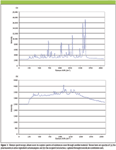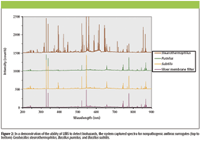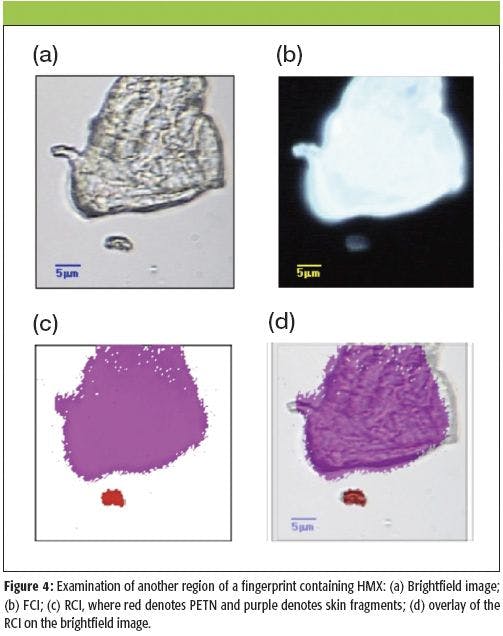Laser-Based Technologies Target Terrorists
Special Issues
Advances in hardware and in data analysis make Raman and laser-assisted spectroscopy techniques valuable in hazardous materials analysis.
We live in the age of information. Having the right information is never more important than in the face of terrorist threats. Is the suitcase left in the airport terminal full of clothing or explosives? Is that powder on the ground dust or a nerve agent? Techniques like Raman spectroscopy, laser-induced breakdown spectroscopy (LIBS), and laser-assisted microwave-plasma spectroscopy (LAMPS) are versatile, accurate, and sensitive solutions to these kinds of scenarios. Used properly, such systems provide both the data and the information that military personnel and first responders need to make our world safer.
Spectroscopy has been used in security and defense applications, including explosives detection, since World War II. As the problems we face become more sophisticated, so must the technology.
One of the challenges faced today in security and defense is the so-called white powder problem. First responders walking onto a scene see a white residue on the floor or a counter that could be sugar . . . or a deadly agent like anthrax. They don't have time to send a sample to the laboratory and wait for a response. They need an answer and they need it now. That's where a technology like Raman spectroscopy can help.
In Raman spectroscopy, photons scatter from molecules in a test sample. During the scattering process, the scattered photons absorb quanta of energy equivalent to a vibrational or rotational energy transition in the scattering molecule. Hence, Raman spectroscopy produces scattered light at a wavelength shifted from that of the incident photon by an amount proportional to the vibrational and rotational modes of the molecular bonds. Raman spectroscopy is a nondestructive molecular analysis technique that can even capture data from samples enclosed in other materials, so long as those materials are transparent to the wavelengths of interest (see Figure 1). The method can be applied across the optical spectrum, from the ultraviolet to the infrared. Unlike conventional near-infrared absorbance spectroscopy, Raman signals are not obscured by the presence of water — the technique can be applied to aqueous samples and solids with a high moisture content.

Figure 1
A number of dangerous substances, including explosives, biosensors, and chemical weapons display Raman signatures, making the technology particularly useful for defense and security applications. Although tabletop, laboratory Raman systems are common, diode lasers have enabled a new generation of economical, handheld Raman spectrometers that can achieve resolutions as low as 6–11 cm-1.
At the Third Research Institute of the Ministry of Public Security in Shanghai, China, researchers are using Raman spectroscopy to detect both crystalline and liquid substances of interest, including drugs, explosives, hazardous liquids, and other dangerous chemicals. The group's AY01-01 Rapid Liquid Contraband detector integrates QE65000 scientific-grade spectrometers from Ocean Optics to distinguish among as many as 200 different compounds. Applications include screening at airports and borders, as well as large public gatherings such as concerts and sporting events.
Shine A Light On It
Of course, Raman spectroscopy is not perfect — it requires sample preparation and cannot be used in standoff mode. LIBS provides an alternative. In LIBS, a pulsed laser ablates a small amount of material from the sample under test, generating a plasma. As the plasma cools, the atoms, ions, and small molecules in the plasma emit photons, which are measured by a spectrometer and analyzed to identify the elemental composition of the material. The technique is particularly useful for elemental analysis or analysis of mixtures.
LIBS offers a number of advantages for security and defense applications. Thanks to advances in compact laser technology, portable, handheld LIBS analyzers are now viable. A laser beam performs the ablation, so analysis can be performed at a distance. Although the technique is not, strictly speaking, nondestructive, the laser ablates only pico-to nanograms of material, so the instruments could even be used at screening points to check luggage or vehicles.
A group at the U.S. Army Research Laboratory has studied the use of LIBS in detecting explosive residues from a distance (1). To combat interference from atmospheric oxygen and nitrogen, the group used a double-pass configuration. The system successfully detected explosives residues at 20 m. Meanwhile, the International Atomic Energy Agency has investigated LIBS for the detection of nuclear materials with an eye toward developing a portable tool for their inspectors. Other groups have investigated the ability of LIBS to search for biohazards (see Figure 2).

Figure 2
Transitioning a technique from a controlled laboratory environment to the real world always entails challenges. Eye safety can be a problem, which has researchers looking at relatively eye-safe wavelengths outside the visible band. The 1–20 μs duration of the LIBS plasma places some limits on the sensitivity of the method compared with continuous methods, such as Raman. That's not necessarily an issue for laboratory research that can take place over the course of days or even weeks, but, in some cases, sensitivity improvements are required.
LAMPS provides a powerful performance improvement for LIBS. The technology combines LIBS hardware with a microwave cavity. In a LAMPS system, the laser pulse acts as a spark to ignite a microwave plasma that lasts for 10–20 ms, depending on the power supply. By extending the duration of the plasma lifetime, LAMPS provides an extended opportunity to capture photons — essentially more time for the spectrometer to make the measurement. Because the microwave cavity converts the laser plasma into a "cooler" plasma, the bremsstrahlung emission — the background white-light continuum — drops significantly. Both factors increase the signal-to-noise ratio (S/N) compared with LIBS.
Although the need for a cavity makes it impossible for LAMPS to operate in stand-off mode, the technology still holds promise for security and defense applications. One can imagine implementing the microwave cavity as a small chamber that a first-responder, for example, could place over a sample to do a rapid analysis.
This technology is still in the development phase. Because of the nature of the plasma, the technique does not enhance all elements equally. Initial tests have shown a better enhancement for lower-energy transitions, generally corresponding with elemental emission lines in the 400-nm and longer-wavelength region. In some cases, LAMPS can enhance sensitivity by as much as an order of magnitude. For other elements and matrices, the effect is negligible; in a study of polymer-based materials, for example, turning the microwave enhancement on or off had little effect on the results.
LAMPS is a promising technology but is not a universal answer. LIBS alone, properly applied, can often supply more information more easily, especially in situations that require portability. Although LAMPS units can operate with samples as small as a few millimeters in dimension, the addition of the electronics and plasma driver hardware increases the size and weight of the device. Power demands limit the battery life and runtime of the instruments. Studies are still underway to determine the minimum wavefront strength required to obtain enhancement, which could provide an avenue to size reduction. Although the units are unlikely to progress to the point of being handheld, they may eventually become portable.
As work progresses, we will better understand which applications will benefit most from its capabilities, and when to use LAMPS or LIBS technology for optimal results.
By The Numbers
Often, the method used for data mining and analysis is just as important as the data acquisition approach. Chemometrics offers a means to significantly improve the usefulness of both LIBS and LAMPS. By combining a number of analysis techniques, users can extract much more information from the data than just basic atomic emission lines.
Each material under test presents a different chemical matrix for analysis. This matrix affects the calibration of the LIBS and LAMPS systems, and calibration directly affects the accuracy of both quantitative and qualitative analyses. In general, it is not possible to test an arbitrary sample for a selection of elements (for example, testing ore for lead, chromium, or nickel) and obtain quantitative or semiquantitative results without substantial information about the matrix and, ideally, some matrix-matched standards. Traditional methods would then analyze individual peaks against a calibration from that library of matrix-matched standards. This approach would work well in theory but poorly in practice for large sample sets, as it is a laborious, time-consuming, and expensive process. Chemometrics provides an alternative.
The term chemometrics refers to a suite of multivariate pattern-recognition methods that detect differences between spectra by leveraging all of the information in each spectrum. A series of standard, known spectra may have multiple elemental lines that are correlated and anti-correlated with a particular element, for example, plus distinctive background features related to the matrix. The algorithm can be tuned to detect the elements of interest. In practice, the user presents the instrument with sufficient numbers of training spectra and identifies them correctly to the software. The algorithm analyzes the various spectra to detect the principal components or most statistically important discriminators. When the user subsequently presents the instrument with an unknown, the software is able to determine the classification descriptors.
Consider an analysis of high-and low-alloy steels. The chemical composition can vary, with some containing high amounts of nickel and chromium and others only traces of manganese. Examining the regression coefficients of the high-alloy steels for a calibration of nickel, the user of a chemometric algorithm would see that the software had correlated the part of the spectrum that has nickel peaks, but also anticorrelated the iron because it has learned that when the nickel levels go up, iron levels go down. That is an example of the power of these multivariate calculations — instead of being dependent on having an exact match in the library in order to perform an analysis, the software can use a nearest-neighbor approach to choose the spectrum closest to the unknown and work the problem from there.
In work recently reported, a group from Caltech supporting the LIBS instrument on a mission to Mars made some very encouraging strides in data analysis. The LIBS system was operating in stand-off mode to analyze the composition of rocks and other surface materials. The Caltech group combined principal-components analysis and soft independent modeling class analogy (SIMCA) to identify mineralogical components, then used a partial-least-squares (PLS-1) multivariate calibration to quantify geological matrices. They found that with their method, even if they didn't have a particular rock composition in their database, they could still do a good job of identification and even quantification.
The results have profound implications for applications like security and defense. Real-world security applications often study mixtures rather than elements. Contamination provides an additional complication. Univariate and standard-calibration methods can't take into account multiple factors. Analyzing multicomponent mixtures under real-world conditions requires chemometrics.
Although the method needs complete data and calibration for quantitative results, that doesn't necessarily pose a problem for security applications. In many cases, what's needed for military and security applications isn't an absolute quantification but rather a fingerprint or an indicator that a problem may exist — a suspicious vehicle merits further inspection, for example.
A key benefit of the chemometrics approach is that the software is self-learning and can be trained for different applications. The Coast Guard is going to face different security problems compared to first responders, and a hazardous materials technician is going to have different needs than personnel searching for IEDs. Chemometrics can allow the same instrument to work effectively in each case. Chemometric methods and software still require a skilled analyst for proper deployment, but the tools are becoming both increasingly sophisticated and common.
We live in dangerous times, but laser-assisted spectroscopy systems are shedding light on security threats. As hardware advances reduce system sizes and increasingly sophisticated software enhances the conversion of data to information, technologies like Raman spectroscopy, LIBS, and LAMPS will play increasingly important roles in making our world safer.
Jason Eichenholz and Kevin Kaye are with Ocean Optics, Inc., Dunedin, Florida. Steve Buckley is with Photon Machines, Inc., Redmond, Washington.
References
(1) F.C. De Lucia Jr., J.L. Gottfried, C.A. Munson, and A.W. Miziolek, Spectrochim. Acta Part B: Atom. Spectrosc. 62, 1399–1404 (2007).

AI Shakes Up Spectroscopy as New Tools Reveal the Secret Life of Molecules
April 14th 2025A leading-edge review led by researchers at Oak Ridge National Laboratory and MIT explores how artificial intelligence is revolutionizing the study of molecular vibrations and phonon dynamics. From infrared and Raman spectroscopy to neutron and X-ray scattering, AI is transforming how scientists interpret vibrational spectra and predict material behaviors.
Real-Time Battery Health Tracking Using Fiber-Optic Sensors
April 9th 2025A new study by researchers from Palo Alto Research Center (PARC, a Xerox Company) and LG Chem Power presents a novel method for real-time battery monitoring using embedded fiber-optic sensors. This approach enhances state-of-charge (SOC) and state-of-health (SOH) estimations, potentially improving the efficiency and lifespan of lithium-ion batteries in electric vehicles (xEVs).
New Study Provides Insights into Chiral Smectic Phases
March 31st 2025Researchers from the Institute of Nuclear Physics Polish Academy of Sciences have unveiled new insights into the molecular arrangement of the 7HH6 compound’s smectic phases using X-ray diffraction (XRD) and infrared (IR) spectroscopy.










